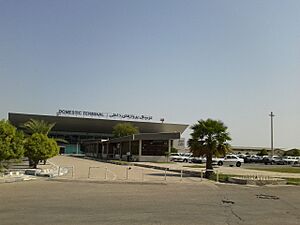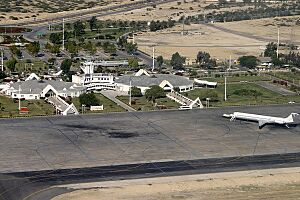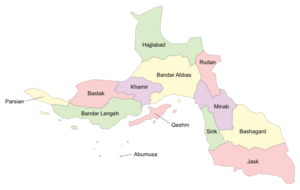Hormozgan province facts for kids
Quick facts for kids
Hormozgan Province
استان هرمزگان
|
|
|---|---|

Map of Iran with Hormozgan province highlighted
|
|
| Country | Iran |
| Region | Region 2 |
| Capital | Bandar Abbas |
| Counties | 13 |
| Area | |
| • Total | 70,697 km2 (27,296 sq mi) |
| Population | |
| • Total | 1,776,415 |
| • Density | 25.12716/km2 (65.0791/sq mi) |
| Time zone | UTC+3:30 (IRST) |
| ISO 3166 code | IR-22 |
| Main language(s) | Mostly Persian, small minority speaks Gulf Arabic and Balochi [1] |
| HDI (2017) | 0.768 high · 25th |
Hormozgan Province (Persian: استان هرمزگان) is one of the 31 provinces of Iran. It is located in the southern part of the country. This province faces the Persian Gulf and countries like Oman and the United Arab Emirates. It also borders the important Strait of Hormuz.
Hormozgan covers an area of about 70,697 square kilometers (27,296 square miles). Its capital city is Bandar Abbas. The province is special because it has fourteen islands in the Persian Gulf and a long coastline of about 1,000 kilometers (620 miles).
In 2016, the population of Hormozgan Province was around 1,776,415 people. This shows a big increase from 2006, when the population was about 1,365,377.
Contents
History of Hormozgan
Hormozgan has a very old history. People lived here even during the time of the Achaemenid Empire, thousands of years ago. The main port, Bandar-e Hormoz, became very important during the Sassanid Empire.
Early Times and Trade
The province was very successful between 241 BC and 211 BC. It grew even more important for trade after the Islamic era began. Famous traveler Marco Polo visited the port of Bandar Abbas in the late 1200s. He saw lots of trading happening there. People traded Persian jewelry, ivory, silk from Indochina, and pearls from Bahrain.
European Arrivals
In 1497, Europeans first arrived in the region, led by Vasco da Gama. A few years later, in 1508, the Portuguese came with warships. They wanted to control the port of Hormuz because it was a very important trading spot in the Persian Gulf.
At first, the Persian rulers could not stop the Portuguese. But later, Shah Abbas I worked with the British to drive the Portuguese out of the Persian Gulf. This is why the city of Bandar Abbas is named after him.
Modern Era Changes
After the Portuguese left, the British and Dutch started to compete for power in the region. The Dutch even sent warships to Bandar Abbas. However, as relations between the British and Dutch worsened, the Dutch moved their base away. This left the British in charge of the Persian Gulf through the British East India Company.
The British wanted local areas to be somewhat independent. This way, no single strong force could threaten their control. After World War I, the Persian Gulf became even more important because oil was discovered there.
Geography and Climate
Hormozgan Province is mostly mountainous. It sits at the southern end of the Zagros Mountains. The climate here is very hot and humid. In summer, temperatures can sometimes go above 49°C (120°F). There is also very little rain throughout the year.
How Hormozgan is Governed
Hormozgan Province is divided into 13 main areas called counties. Each county has its own towns and villages. The population of these counties has grown a lot over the years.
Most Populous Cities
Many people in Hormozgan live in cities. Here are some of the largest cities in the province, based on the 2016 census:
| Rank | City | County | Population |
|---|---|---|---|
| 1 | Bandar Abbas | Bandar Abbas | 526,648 |
| 2 | Minab | Minab | 73,170 |
| 3 | Qeshm | Qeshm | 40,678 |
| 4 | Kish | Bandar Lengeh | 39,853 |
| 5 | Rudan | Rudan | 36,121 |
| 6 | Bandar Lengeh | Bandar Lengeh | 30,435 |
| 7 | Hajjiabad | Hajjiabad | 28,977 |
| 8 | Kong | Bandar Lengeh | 19,213 |
| 9 | Parsian | Parsian | 18,045 |
| 10 | Jask | Jask | 16,860 |
Demographics
Most people in Hormozgan speak Persian. However, there are also smaller groups who speak Balochi and Arabic.
| Hormozgan Linguistic Composition | ||||
|---|---|---|---|---|
| language | percent | |||
| Persian | 81.78% | |||
| Balochi | 7.31% | |||
| Arabic | 2% | |||
| Bashkardi | 1.63% | |||
| Other, mixed | 7.27% | |||
Life in Hormozgan Today
Hormozgan is a busy and important province today. It has 11 ports, five national airports, and three international airports. This makes it a key place for trade and travel.
The province is also strong in agriculture. It is number one in Iran for producing limes and number two for dates. About 30% of all the fish caught in Iran come from this province. Three large dams help provide water for the people and farms in Hormozgan.
There are also two special free trade zones in Hormozgan: one on Kish Island and another on Qeshm Island. These zones help boost business and trade. Kish Island is even home to the Iranian oil bourse, which is a special market for trading oil.
Fun Places to Visit
Hormozgan has many interesting places to visit. The Cultural Heritage Organization of Iran lists 212 historical and cultural sites here. Some popular attractions include:
- Emarat-e Kolah Farangi: A building from the time of Dutch occupation.
- Berkeh haye Baran: Six traditional water reservoirs.
- The Hindu temple: An old temple with unique architecture.
- Latidan Bridge: A bridge built during the time of Shah Abbas I.
- Fort of Our Lady of the Conception in Hormoz island: An old Portuguese castle on Hormuz Island.
- Qeshm Island: A large island known for its unique geological formations and natural beauty.
- Hara marine forests: Special mangrove forests that grow in saltwater.
- Kish Island: A very popular tourist spot in southern Iran, known for its beaches and shopping.
- Geno UNESCO natural biosphere reserve: A protected area with diverse plants and animals.
- Hara UNESCO natural biosphere reserve: Another important protected area, home to the mangrove forests.
- Various hot water springs: Natural springs with warm water.
Learning and Education
Hormozgan is also a place for learning. It has several universities and colleges where students can study different subjects:
- Bandar Abbas University of Medical Sciences
- University of Hormozgan
- Qeshm Institute of Higher Education
- Islamic Azad University of Bandar Abbas
- Payame Noor University of Hormozgan
- Islamic Azad University of Roudan
- Kish University
See also
 In Spanish: Provincia de Hormozgán para niños
In Spanish: Provincia de Hormozgán para niños
- Bandar Abbas
- Bastak
- Kookherd
- Maghoh
- Mir-Mahna (video game)
- Morbagh
- Ormus
- The Historic Bath of Siba—An ancient bath house that is believed dated back to the Sassanid dynasty.





